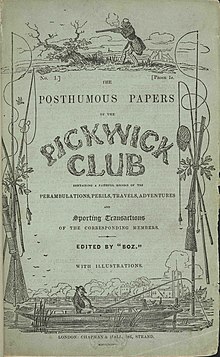The Pickwick Papers

Original cover issued in 1836
|
|
| Author | Charles Dickens ("Boz") |
|---|---|
| Original title | The Posthumous Papers of the Pickwick Club, Containing a Faithful Record of the Perambulations, Perils, Travels, Adventures and Sporting Transactions of the Corresponding Members |
| Illustrator |
Robert Seymour Robert William Buss Hablot Knight Browne (Phiz) |
| Country | England |
| Language | English |
| Subject | Travels in the English Countryside |
| Genre | Novel |
| Published | Serialised April 1836 – November 1837; book format 1837 |
| Publisher | Chapman & Hall |
| Media type | |
The Posthumous Papers of the Pickwick Club (also known as The Pickwick Papers) was Charles Dickens's first novel. He was asked to contribute to the project as an up-and-coming writer following the success of Sketches by Boz, published in 1836 (most of Dickens' novels were issued in shilling instalments before being published as complete volumes). Dickens (still writing under the pseudonym of Boz) increasingly took over the unsuccessful monthly publication after the original illustrator Robert Seymour had committed suicide.
With the introduction of Sam Weller in chapter 10, the book became the first real publishing phenomenon, with bootleg copies, theatrical performances, Sam Weller joke books, and other merchandise.
After the publication, the widow of Robert Seymour claimed that the idea for the novel was originally her husband's; however, in his preface to the 1867 edition, Dickens strenuously denied any specific input, writing that "Mr Seymour never originated or suggested an incident, a phrase, or a word, to be found in the book."
Dickens, a young writer, 24 years old, was working as a Parliamentary reporter and a roving journalist; a collection of his "colour" sketches mainly of London life had been published as Sketches by Boz. A firm of London publishers, Messrs. Chapman and Hall, was then projecting a series of "cockney sporting plates" by illustrator Robert Seymour. There was to be a club, the members of which were to be sent on hunting and fishing expeditions into the country. Their guns were to go off by accident; fishhooks were to get caught in their hats and trousers. All these and other misadventures were to be depicted in Seymour's comic plates.
At this juncture, Charles Dickens was called in to supply the letterpress – that is, the description necessary to explain the plates and connect them into a sort of picture novel such as was then the fashion. Though protesting that he knew nothing of sport, Dickens nevertheless accepted the commission; he consented to the machinery of a club, and in accordance with the original design sketched Mr Winkle who aims at a sparrow only to miss it.
Only in a few instances did Dickens adjust his narrative to plates that had been prepared for him. Typically, he himself led the way with an instalment of his story, and the artist was compelled to illustrate what Dickens had already written. The story thus became the prime source of interest, and the illustrations merely of secondary importance. By this reversal of interest, Dickens transformed, at a stroke, a current type of fiction, consisting mostly of pictures, into a novel of contemporary London life. Simple as the process may appear, others who had tried the plan had all failed. Pierce Egan partially succeeded in his Tom and Jerry, a novel in which the pictures and the letterpress are held in even balance. Dickens won a complete triumph. In future years, however, Dickens was suspiciously eager to distance himself from suggestions that Pierce Egan's Life in London had been a formative influence.
...
Wikipedia
